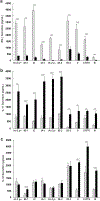Different Propionibacterium acnes Phylotypes Induce Distinct Immune Responses and Express Unique Surface and Secreted Proteomes
- PMID: 27377696
- PMCID: PMC8295477
- DOI: 10.1016/j.jid.2016.06.615
Different Propionibacterium acnes Phylotypes Induce Distinct Immune Responses and Express Unique Surface and Secreted Proteomes
Abstract
Propionibacterium acnes is a skin commensal bacterium that contributes to the development of acne vulgaris and other infections. Recent work revealed that P. acnes clinical isolates can be classified into distinct phylotypes, several of which have associations with healthy skin or acne. We sought to determine if these phylotypes induce different immunological responses and express protein factors that may contribute to their disease associations. We found that acne-associated P. acnes phylotypes induced 2- to 3-fold higher levels of IFN-γ and IL-17 in peripheral blood mononuclear cells compared with healthy phylotypes. On the other hand, P. acnes phylotypes associated with healthy skin induced 2- to 4-fold higher levels of IL-10. Comparative proteomic analysis of P. acnes phylotypes revealed a differential expression of several proteins, including an adhesion protein that was expressed at least 10-fold higher in acne-associated phylotypes and a cell surface hydrolase expressed in all phylotypes except those associated with healthy skin. Taken together, our data provide insight into how specific P. acnes phylotypes influence immune responses and the pathogenesis of acne.
Copyright © 2016 The Authors. Published by Elsevier Inc. All rights reserved.
Conflict of interest statement
CONFLICT OF INTEREST
YY, JC, and JK have filed for a patent related to this study.
Figures




References
-
- Altschul SF, Gish W, Miller W, Myers EW, Lipman DJ. Basic local alignment search tool. J Mol Biol 1990;215:403–10. - PubMed
-
- Beylot C, Auffret N, Poli F, Claudel JP, Leccia MT, Del Giudice P, et al. Propionibacterium acnes: an update on its role in the pathogenesis of acne. J Eur Acad Dermatol Venereol 2014;28:271–8. - PubMed
-
- Bhate K, Williams HC. Epidemiology of acne vulgaris. Br J Dermatol 2013;168:474–85. - PubMed
-
- Bond NJ, Shliaha PV, Lilley KS, Gatto L. Improving qualitative and quantitative performance for MS(E)-based label-free proteomics. J Proteome Res 2013;12:2340–53. - PubMed
MeSH terms
Substances
Grants and funding
LinkOut - more resources
Full Text Sources
Other Literature Sources
Medical

